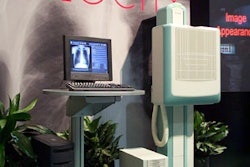The performance of storage-phosphor computed radiography is markedly superior to that of screen-film radiography for detecting low-contrast catheter materials on bedside chest x-rays, regardless of the dose level, according to researchers from the University of Vienna in Austria.
Dr. Edith Eisenhuber and colleagues from the university’s radiology department and the Ludwig Boltzmann-Institute for Clinical and Experimental Radiologic Research set out to evaluate conventional bedside chest radiography in comparison to digital storage phosphor systems.
The latter "have been shown to provide more consistent image quality...regardless of acquired exposure dose," the authors wrote. "The most recent storage-phosphor plates, ST-V and ST-Vn (Fujifilm Medical Systems, Tokyo), are characterized by a substantially improved quantum efficiency. Assessment of correction positioning of various monitoring and support devices is one of the most frequent indications for routine bedside chest radiography" (Radiology, April 2003, Vol. 227:1, pp. 216-221).
The study population consisted of 10 patients who were scheduled to undergo clincally indicated bedside chest x-ray between January and March 2001. Of these 10, seven were mechanically ventilated; five had cardiac failure; six had pleural effusions; and three had intrapulmonary opacities because of atelectasis or pneumonic infiltrates.
Bedside chest radiographs were obtained over four consecutive days with a 400-speed conventional screen-film system (Insight VHC, Eastman Kodak, Rochester, NY) and with storage-phosphor plates with exposure levels comparable to screen-film speeds of 200, 400, and 800 (FCR 5000, Fujifilm Medical Systems, Tokyo).
All x-rays were done with patients in the supine position, and images were obtained on a portable x-ray system (Mobilett II, Siemens Medical Solutions, Erlangen, Germany). Finally, the acquisition radiation dose ranged from 1.25 to 2.2 mAs.
The radiographs were independently analyzed by six thoracic radiologists with experience ranging from 2 to 16 years. The readers were asked to note the presence or absence of a catheter fragment by using a five-score confidence scale (1=definitely not present; 5=definitely present). An ROC analysis was performed (Medcalc Software, Mariakerke, Belgium).
According to the results, the detection performance of the storage-phosphor plates was significantly superior to that of the screen-film system at all three dose levels, the authors reported. Increasing the dose to a 200-speed system did not increase detection performance compared to the 400-speed digital film, they said.
Catheter localization in a high-attenuation, low optical density (OD) area (central portion of the mediastinum) was better with the 200- and 400-speed storage-phosphor x-rays. The same was true for the intermediate-attenuation, intermediate OD area (retrocardiac and retrodiaphragmatic spaces; chest wall).
Based on the ROC analysis, the screen-film detection performance (mean area under the ROC curve, Az) was Az=0.76. For the digital system, the Az=0.88, 0.87, and 0.83 for the 200-, 400-, and 800-speed doses, respectively.
However, in the lungs (low attention area, high OD), the authors found no difference between the screen-film and storage-phosphor radiographs, they wrote.
"The most recent generation of storage-phosphor plates is superior to a 400-speed screen-film system, even at an exposure level of 800 speed...an increased dose does not result in further improvement in the detection performance of a digital (intensive care unit) chest radiograph," the authors concluded.
Some of the limitations of this study included the small number of patients and a possible learning bias among the readers as two versions of the same template were reviewed during a session, the group acknowledged. Also, an anti-scatter grid, which requires a certain amount of operator experience, was used in the study.
By Shalmali PalAuntMinnie.com staff writer
May 26, 2003
Related Reading
Routine chest x-rays don’t enhance thoracotomy catheter assessment, March 24, 2003
DR permits lower chest dose than film or CR, January 30, 2003
Bigger not necessarily better for digital chest x-ray matrix, January 15, 2002
Copyright © 2003 AuntMinnie.com



















